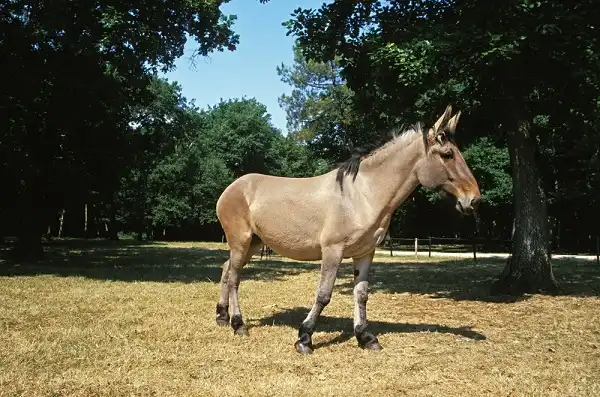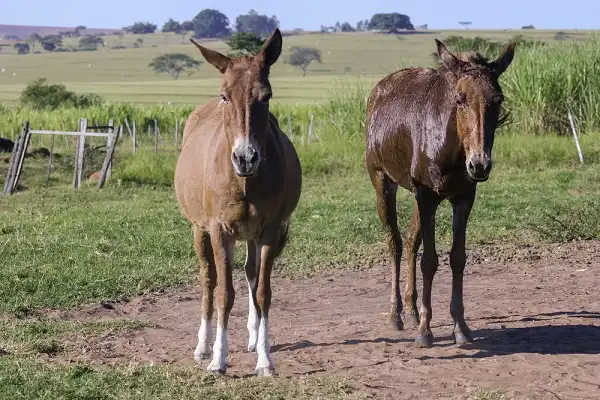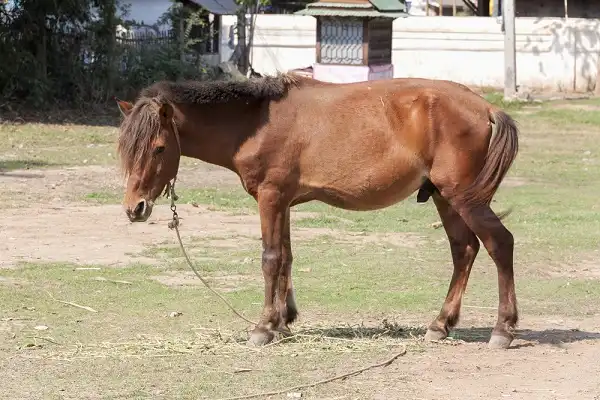Do you ever feel like there are just not enough hours in the day? Do you sometimes wish that you had an extra set of hands to help with your workload? Well, what if I told you that there’s a four-footed animal designed to carry heavy loads and provide extra assistance when it comes to manual labor – the mighty mule? Mules have been around for centuries and are known worldwide for their strength, intelligence, friendly nature, and dependability. In this blog post, we dive deep into mules: where they came from, why they’re so great for hard labor tasks and farming jobs, as well as how to care for them properly. So put on your farm boots because it’s time to explore everything about mules!

Mule Description
Mules are a sturdy, strong breed of the equine family that has existed since ancient times. They are a hybrid of a horse and donkey and have been praised for their hardiness, intelligence, and strength. Their coat is usually made up of coats from both parents – they often have grayish-brown or sandy-colored fur with white legs and a white muzzle. Mules are known for their exceptional stamina and surefootedness which makes them ideal for work in rough terrain. They are also highly intelligent animals with an independent streak which makes them difficult to train at times, but it also gives them an edge when it comes to problem-solving tasks required for manual labor such as hauling logs or carrying heavy loads over long distances.
Mule Habitat
Mules are adapted to a wide range of habitats and climates, from humid rainforests to dry deserts. They are generally found in areas with temperate climates, such as the American West, Central America, and parts of Europe and Asia. Mules tend to thrive in open grasslands where they can graze freely, but they are also comfortable living in wooded areas as long as they have access to forage. Mules require plenty of room for exercise when kept in captivity and should never be confined to small spaces for prolonged periods of time. In the wild, they typically roam around large meadows or prairies eating grasses or browsing on shrubs.
Mules tend to be natural herd animals and prefer living together in groups or pairs rather than alone. This helps them build strong social bonds which can improve their overall health and well-being. Mules have evolved over time to become hardy equines capable of surviving harsh conditions such as cold winters, hot summers, and rugged terrain. Their hooves are slightly narrower than those of horses which allows them better traction when traversing rocky or uneven surfaces. Additionally, their fur is shorter than horses which makes it easier for them to stay cool during hot days while still providing adequate protection from cold winds during the winter months.
Mule Diet
Mules are herbivorous animals and feed mainly on grasses, hay, grains, and other plant-based foods. They require a balanced diet that meets their nutritional needs in order to stay healthy and strong. In general, mules should be given access to unlimited amounts of high-quality hay with added grains or supplements depending on the individual animal’s age and activity level. Mules also benefit from being able to graze free-choice on fresh pasture grass when available. Pasture forage is an excellent source of vitamins, minerals, antioxidants, and fiber which helps maintain a healthy digestive system as well as promoting overall health. Mules need plenty of clean water daily as well – at least one gallon per 100 lbs of body weight – to stay properly hydrated and avoid dehydration.
It is important to provide your mule with a variety of options so they have enough variety in their diet for optimal health and nutrition. Different types of hay such as alfalfa or timothy can be used in combination with grains like oats or barley for added energy while fresh vegetables such as carrots or apples provide essential vitamins and minerals. Feeding your mule too much grain at once can lead to colic or other digestive issues so it is important to monitor how much grain you are giving them daily and adjust accordingly if necessary.

Mule Size
Mules are generally known to be quite large animals, with adult animals usually reaching heights of up to 16 hands (64 inches or 1.6 meters) and weights between 800-1,200 pounds (362-544 kg). They are a hybrid of a horse and donkey, and this combination leads to their sturdy build and powerful legs which give them the strength to carry heavy loads over long distances. In addition to their size, mules also have narrower hoofs than horses which gives them better traction for navigating rocky or other uneven terrain.
Mule Lifespan
Mules are hardy equines who have the potential to live a long and healthy life, with proper care and management. Their lifespan is typically 25-30 years, however, some mules have been known to reach up to 40 years of age! In order for mules to reach this age they require special care such as regular grooming, hoof trimming, exercise, dental hygiene, and annual vaccinations against common diseases such as West Nile virus or rabies. Additionally, regular veterinary checkups every 6 months can help ensure your mule remains in good health throughout their life. Finally, mules should be given plenty of space for exercise when kept in captivity to prevent boredom and lack of stimulation that can lead to physical and mental health problems over time. They are naturally herd animals so having other equine companions around them can also help increase their overall wellbeing by providing companionship and social interaction.
Mule Behavior
Mules are known for their intelligence and independent streak, which makes them great draft animals but difficult to train. They have a calm temperament but can be headstrong and stubborn when they don’t want to do something, so it’s important to use positive reinforcement training methods when working with mules. Mules often display a loyal and gentle nature towards humans, so spending quality time with them can help build trust and cooperation. Mules are very social creatures who enjoy spending time in the company of both people and other equines. This socialization is essential for mules to remain healthy both physically and mentally, as it provides them with stimulation, companionship, and opportunities for play. Although mules tend to be quite clever, they require mental stimulation to stay engaged in activities. Introducing new challenges or activities such as obstacle courses or agility drills can help keep their minds active while providing a fun outlet for exercise.

Mule Speed
Mules are not known for their speed or agility, but rather for their strength and endurance. On average, full-grown mules can reach speeds of up to 12 miles per hour over short distances, but cannot maintain such high speeds for long. When running on level ground, they are only capable of maintaining a speed of around 4 miles per hour. However, due to their hybrid genetics which gives them a blend of the power and agility of both horses and donkeys, mules can often outrun horses when it comes to navigating rocky or uneven terrain. In terms of stamina, mules have greater endurance than horses due to their hybrid genetics. As a result, they can often travel longer distances than horses without getting tired as quickly. This makes them perfect for logging and other heavy labor tasks that may require traversing rugged trails or carrying heavy loads over extended periods of time.
Mule Hunting
Mule hunting is a popular sport among experienced hunters, as they are one of the few animals that can be hunted with both firearms and archery equipment. Mules are an attractive target for hunting due to their unique blend of power, speed, and agility that make them an incredibly challenging quarry. When hunting mules it is important to have the right gear. For those using firearms, a rifle or shotgun chambered in large caliber ammunition is recommended such as .30-06 or 12 gauge. It is also wise to wear camouflage clothing while stalking mules as they have excellent vision and can spot intruders from far away. Archery hunters will need a powerful bow with arrows designed for large games such as elk or moose.
Mule hunting season varies depending on location but typically begins in late October and lasts until mid-December. During this period, mules tend to congregate into larger herds which makes them easier to locate and hunt. When scouting for potential spots it’s important to look for areas where mules have access to water sources and abundant forage such as grasses and shrubs. As with any hunt, it’s important to plan accordingly by researching the terrain, obtaining required permits, learning about local laws and regulations, and being prepared for any unexpected scenarios while out in the field.
Mule Transportation
Mule transportation is a reliable and efficient way to transport goods over long distances. Mules have been used for centuries to haul heavy loads through tough terrain, and they are still popular today due to their hybrid genetics which gives them great strength and endurance. The mule’s combination of speed, agility, and power makes them an ideal choice for transporting goods in remote areas or across difficult terrain. Mules can carry up to 800 lbs of goods on their backs over long distances without becoming winded as quickly as horses. They are also excellent climbers and can traverse hilly or rocky terrain with ease.
This allows muleteers to save time by avoiding roads that may be congested or difficult to navigate due to traffic. Additionally, mules require minimal maintenance compared to horses or donkeys, and they are generally more resilient against diseases such as equine flu or colic. When loaded properly, mules can pull a cart that is twice the size of the one pulled by a horse. This makes them well-suited for hauling large loads such as timber or mining equipment over extended periods of time. Mules also do not spook easily when confronted with unexpected noises or obstacles, making them safer animals for transporting goods in unfamiliar areas where wild animals may be present.

Conclusion
Mules are an incredibly hardworking and versatile animal that has been bred for centuries to provide humans with reliable labor and transportation. With a blend of power, agility, and stamina from both horses and donkeys, mules have become popular amongst those who need help with manual labor tasks such as hunting or transporting goods over long distances in difficult terrain. They also make great companions for those looking for an independent yet gentle equine friend. Whether you’re looking to add a mule to your family or use them for work purposes, understanding their unique qualities can help you get the most out of this remarkable animal.
Frequently Asked Question


